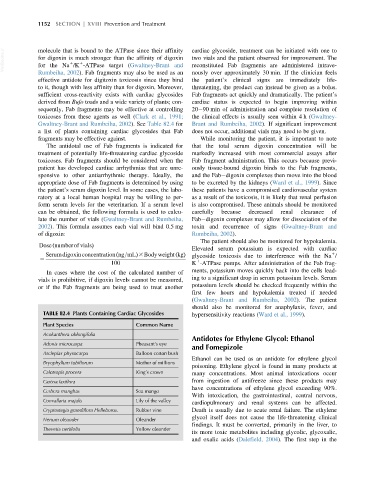Page 1221 - Veterinary Toxicology, Basic and Clinical Principles, 3rd Edition
P. 1221
1152 SECTION | XVIII Prevention and Treatment
VetBooks.ir molecule that is bound to the ATPase since their affinity cardiac glycoside, treatment can be initiated with one to
two vials and the patient observed for improvement. The
for digoxin is much stronger than the affinity of digoxin
1
1
for the Na /K -ATPase target (Gwaltney-Brant and
reconstituted Fab fragments are administered intrave-
Rumbeiha, 2002). Fab fragments may also be used as an nously over approximately 30 min. If the clinician feels
effective antidote for digitoxin toxicosis since they bind the patient’s clinical signs are immediately life-
to it, though with less affinity than for digoxin. Moreover, threatening, the product can instead be given as a bolus.
sufficient cross-reactivity exists with cardiac glycosides Fab fragments act quickly and dramatically. The patient’s
derived from Bufo toads and a wide variety of plants; con- cardiac status is expected to begin improving within
sequently, Fab fragments may be effective at controlling 20 90 min of administration and complete resolution of
toxicoses from these agents as well (Clark et al., 1991; the clinical effects is usually seen within 4 h (Gwaltney-
Gwaltney-Brant and Rumbeiha, 2002). See Table 82.4 for Brant and Rumbeiha, 2002). If significant improvement
a list of plants containing cardiac glycosides that Fab does not occur, additional vials may need to be given.
fragments may be effective against. While monitoring the patient, it is important to note
The antidotal use of Fab fragments is indicated for that the total serum digoxin concentration will be
treatment of potentially life-threatening cardiac glycoside markedly increased with most commercial assays after
toxicoses. Fab fragments should be considered when the Fab fragment administration. This occurs because previ-
patient has developed cardiac arrhythmias that are unre- ously tissue-bound digoxin binds to the Fab fragments,
sponsive to other antiarrhythmic therapy. Ideally, the and the Fab digoxin complexes then move into the blood
appropriate dose of Fab fragments is determined by using to be excreted by the kidneys (Ward et al., 1999). Since
the patient’s serum digoxin level. In some cases, the labo- these patients have a compromised cardiovascular system
ratory at a local human hospital may be willing to per- as a result of the toxicosis, it is likely that renal perfusion
form serum levels for the veterinarian. If a serum level is also compromised. These animals should be monitored
can be obtained, the following formula is used to calcu- carefully because decreased renal clearance of
late the number of vials (Gwaltney-Brant and Rumbeiha, Fab digoxin complexes may allow for dissociation of the
2002). This formula assumes each vial will bind 0.5 mg toxin and recurrence of signs (Gwaltney-Brant and
of digoxin: Rumbeiha, 2002).
The patient should also be monitored for hypokalemia.
Doseðnumberof vialsÞ
Elevated serum potassium is expected with cardiac
1
Serumdigoxinconcentrationðng=mLÞ3BodyweightðkgÞ glycoside toxicosis due to interference with the Na /
5 1
100 K -ATPase pumps. After administration of the Fab frag-
ments, potassium moves quickly back into the cells lead-
In cases where the cost of the calculated number of
ing to a significant drop in serum potassium levels. Serum
vials is prohibitive, if digoxin levels cannot be measured,
potassium levels should be checked frequently within the
or if the Fab fragments are being used to treat another
first few hours and hypokalemia treated if needed
(Gwaltney-Brant and Rumbeiha, 2002). The patient
should also be monitored for anaphylaxis, fever, and
TABLE 82.4 Plants Containing Cardiac Glycosides hypersensitivity reactions (Ward et al., 1999).
Plant Species Common Name
Acokanthera oblongifolia
Antidotes for Ethylene Glycol: Ethanol
Adonis microcarpa Pheasant’s eye
and Fomepizole
Asclepias physocarpa Balloon cotton bush
Ethanol can be used as an antidote for ethylene glycol
Bryophyllum tubiflorum Mother of millions
poisoning. Ethylene glycol is found in many products at
Calotropis procera King’s crown many concentrations. Most animal intoxications occur
Carissa laxiflora from ingestion of antifreeze since these products may
have concentrations of ethylene glycol exceeding 90%.
Cerbera manghas Sea mango
With intoxication, the gastrointestinal, central nervous,
Convallaria majalis Lily of the valley
cardiopulmonary and renal systems can be affected.
Cryptostegia grandiflora Helleboros. Rubber vine Death is usually due to acute renal failure. The ethylene
glycol itself does not cause the life-threatening clinical
Nerium oleander Oleander
findings. It must be converted, primarily in the liver, to
Thevetia neriifolia Yellow oleander
its more toxic metabolites including glycolic, glycoxalic,
and oxalic acids (Dalefield, 2004). The first step in the

